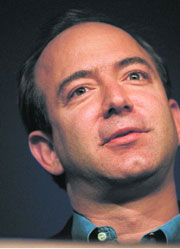“IT’S ALWAYS DAY 1,” Amazon.com‘s founder Jeff Bezos likes to say. Last fall, when a group of Amazon’s customer service reps launched their unionization campaign, they called the effort Day 2—signifying that it was high time for Amazon to stop being a wild young start-up and start acting, in the organizers’ words, like “a mature company.”
So much for answered prayers.
Last week’s layoffs of 1,300 Amazon workers indeed heralded the arrival of a new, “mature” era for the company. The days of being a warm, fuzzy reflection of its happy-faced founder are over. In the future, it seems, Amazon will abide by the same principles that guide any other profit-driven corporation, with no sentimental attachment to its hometown or to the young over-educated dreamers who helped build the company.
The closure of Amazon’s downtown 400-person customer service unit and the partial shutdown of the Georgetown distribution center were almost inevitable when viewed in the context of the company’s recent expansion activities. Over the last year and a half, Amazon has opened up a half-dozen new facilities, not one of which is in a thriving metropolitan area like Seattle. Instead, Amazon has turned to rather less desirable, and less expensive, parts of the country, such as Campbellsville, Ky., a town with a recent unemployment rate of over 20 percent, and Huntington, W.Va., a city currently running a $5 million budget deficit. To attract Amazon, eager state and local governments have provided tens of millions of dollars in “incentives,” including everything from tax breaks to paying for the company’s office equipment.
Amazon, in short, is looking less like a homegrown exponent of some kind of New Economy enlightenment than a pure reflection of WTO-style cross-border capitalism. Highly paid knowledge workers (executives, editors, engineers, marketers, and the like), with their in-demand skills and refined lifestyles, will be concentrated in Seattle office towers. All other jobs will be shipped out to where they can be done more cheaply and efficiently by employees who are a bit more grateful than the unionizing rabble in the local customer service unit.
Indeed, the demands put forward by the Day 2 activists—”we require a work schedule that supports our personal lives outside of the workplace,” etc.—look sadly deluded when viewed in the context of Amazon’s reception elsewhere. Witness the giant banner headline on the front page of The Herald-Dispatch newspaper in Huntington last spring: “A GREAT DAY FOR W.VA.” Jeff Bezos had come to town, announcing his intention to hire 150 people to work at a new customer service center for $8.50 an hour (with the head count projected to hit 375 during the Christmas rush). West Virginia Governor Cecil Underwood called Amazon’s decision “one of the greatest things that’s happened in West Virginia”; US Senator Jay Rockefeller issued a celebratory statement.
The city of Huntington, already strapped for cash, sold $4 million in bonds to cover building renovations for Amazon and to pay for computers and furniture—a move that may have exceeded even West Virginian standards of propriety. Last week state auditors said they were investigating the arrangement to see if Huntington had blown scarce revenues on Amazon that should have been used to cover city workers’ pensions and other unpaid bills. “When you’re trying to attract economic development, you can sell the farm, but only up to a point,” says Lisa Thornburg, West Virginia’s deputy state auditor.
While some customer service reps in Seattle think they were targeted because of their efforts to unionize, it seems more likely they were just victims of their own success. Amazon and other dot-coms helped to inflate hugely the cost of living around here, driving up wages and tightening the labor market. As a result, it’s becoming harder to keep these big “call centers” in town. Richard Chapman of Seattle’s Economic Development Council says there’s been “a pretty big drop-off” in call centers looking to locate here. Most are moving to South King County or Federal Way, away from the pricey downtown office towers where Amazonians toiled.
Ticketmaster, for example, which has 80 people taking calls in Seattle, is moving its Northwest phone operation to Pharr, Texas, next month. The company says it’s been too difficult to find staff around here. Since these operations work 24 hours a day, Chapman notes, “you can have them around the world.” Amazon has sent some of its customer support jobs to India.
BUT CUSTOMER SERVICE reps are only part of the story. Another reason Amazon is looking more old school than New Economy is that the company made a decision some years back not to be just a Web site and marketing outfit but to handle all the warehousing and delivery of its merchandise as well. (Many retailers contract out these functions.) The idea was that Amazon would control every aspect of the customer experience, “from click to ship,” as Bezos puts it.
As a consequence, Amazon has developed a big Old Economy appetite for cheap land and cheap labor. It has taken over and remodeled a string of giant warehouse/ distribution centers in places like Coffeyville, Kan.; Campbellsville, Ky.; and—most nightmarishly familiar to Seattle minions—Fernley, Nev., outside Reno (where local Amazonian cubicle dwellers were sent to pack boxes before Christmas). These facilities dwarfed the original Georgetown warehouse, which Amazon now intends to use only during the holidays.
So long as Amazon keeps this strong blue-collar streak, it will continue to be subject to unionization campaigns—despite having sloughed off those pesky activists from Day 2. A nonprofit group called the Prewitt Organizing Fund is targeting Amazon’s distribution centers, especially the one in Campbellsville.
It’s unclear whether Amazon intends to stick with its “click-to-ship” strategy for the long term or not. Bezos has sent mixed signals, at once declaring it to be “a huge competitive advantage for us,” at other times intimating that he might ditch the delivery side of the business entirely.
Whether or not Amazon stays in the delivery business, its sales have proved insufficient to support what the company’s built. Last week, Amazon announced it would shutter its state-of-the-art $50 million distribution center in Georgia, the facility it had most recently opened. “My guess would be the [sales] volume is just not warranting the capacity they developed,” says Brian Gibson, an associate professor of logistics at Auburn University, who has consulted with Amazon in the past. “Or they may be operating more efficiently, managing their inventory better.”
All in all, after last week, it’s clear Bezos should try out a new clich麠Growing up is hard to do.
For more on dot-com deaths at Amazon, read Kiss My ASCII.








